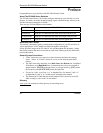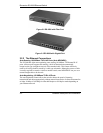
Dimension ES-2008 Ethernet Switch
1-4 Getting to Know Your ES-2008
Figure 1-2 Bridging Application Example
1.4.3 VLAN Application
VLAN (Virtual Local Area Network) allows a physical network to be partitioned into
multiple logical networks. Stations on a logical network belong to one group. A station
can belong to more than one group. With VLAN, a station cannot directly talk to or hear
from stations that are not in the same group(s); the traffic must first go through a router.
As well as security, VLANs also increase network performance by limiting broadcasts to
a smaller and more manageable logical broadcast domain. In traditional switched
environments, all broadcast packets go to each and every individual port. With VLAN,
broadcasts are confined to the members of the VLAN. Note that VLANs are
unidirectional - they only govern outgoing traffic.
Port-based VLANs are VLANs where the packet forwarding decision is based on the
destination MAC address and its associated port.


















